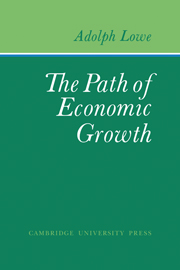Book contents
- Frontmatter
- Contents
- Preface
- Acknowledgments
- PART I The Basic Model
- PART II Changes in the Rate of Change
- PART III Changes in the Rate of Change
- PART IV Changes in the Rate of Change
- 21 The Scope of the Investigation
- 22 Dynamic Equilibrium Once More
- 23 Nonneutral Innovations: A General Survey
- 24 Pure Labor-Displacing Innovations
- 25 Pure Capital-Displacing Innovations
- 26 Some Comments on Combined Changes in the Input of Labor and Capital
- 27 Technical Progress and Diminishing Returns
- 28 Some Concluding Remarks
- Appendix: An Alternative Presentation of Lowe's Basic Model
- Glossary of Recurring Symbols
- Name Index
- Subject Index
26 - Some Comments on Combined Changes in the Input of Labor and Capital
Published online by Cambridge University Press: 07 October 2011
- Frontmatter
- Contents
- Preface
- Acknowledgments
- PART I The Basic Model
- PART II Changes in the Rate of Change
- PART III Changes in the Rate of Change
- PART IV Changes in the Rate of Change
- 21 The Scope of the Investigation
- 22 Dynamic Equilibrium Once More
- 23 Nonneutral Innovations: A General Survey
- 24 Pure Labor-Displacing Innovations
- 25 Pure Capital-Displacing Innovations
- 26 Some Comments on Combined Changes in the Input of Labor and Capital
- 27 Technical Progress and Diminishing Returns
- 28 Some Concluding Remarks
- Appendix: An Alternative Presentation of Lowe's Basic Model
- Glossary of Recurring Symbols
- Name Index
- Subject Index
Summary
Pure labor-displacing and pure capital-displacing innovations supply us with the basic structural models from which the more complex and more realistic cases of combined changes in the input of labor and capital can be derived.
1. The most important case, which is also the center of Marx's macrodynamics, is represented by capital-attracting, labor-displacing innovations. So far as the traverse from the initial impact to the terminal equilibrium is concerned, this category presents the same problems that we discussed extensively under Pure Labor-Displacing Innovations. However, its capital-attracting nature requires an initial process of net capital formation combined with the gradual transmutation of the initial capital stock, before the innovational impact can even get under way. Again, in analogy with pure capital-displacing innovations, current amortization sums provide some of the funds required for transmutation. It depends on the degree of capital intensification by how much these amortization funds fall short of the total required for the necessary capital formation. If no additional voluntary or forced savings are provided, this process of the gradual transmutation of the old into the new capital stock will be long drawn out.
2. We find quite a different situation when we turn to capital-displacing, labor-attracting innovations. The capital-displacing effects and the requirements for their accommodation are similar to those studied under Pure Capital-Displacing Innovations. A new issue arises however, from the need to increase labor input per unit of output.
- Type
- Chapter
- Information
- The Path of Economic Growth , pp. 272 - 274Publisher: Cambridge University PressPrint publication year: 1976



